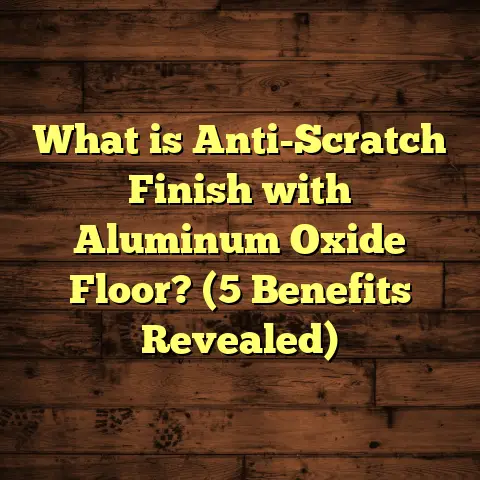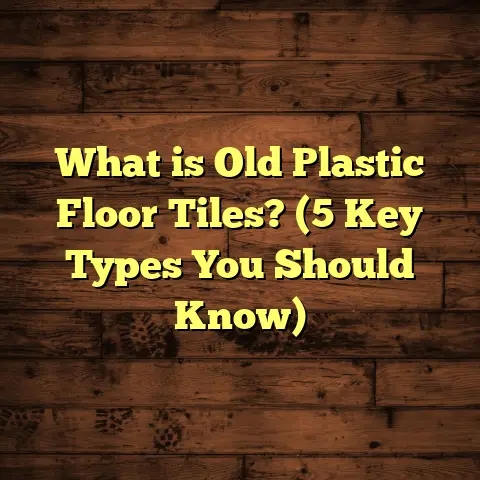What is Kitchen Flooring Trending? (5 Styles You Can’t Miss!)
Focusing on Luxury: The Latest in Kitchen Flooring Styles
When I think about luxury in a kitchen, the flooring is one of the first things that come to mind. The floor is literally where every step begins—it’s the foundation of your kitchen’s look and feel. Over the years, I’ve learned that luxury isn’t just about expensive materials or flashy finishes; it’s about creating a space that feels elegant, inviting, and built to last. And trust me, the right kitchen flooring can make or break that vibe.
I remember a client in San Francisco who wanted a kitchen floor that would feel both warm and sophisticated but could also handle the chaos of two energetic kids. We settled on a wide-plank hardwood with a matte finish, and it was a game changer. The floor looked stunning and stood up to spills and scratches without losing its charm. That’s what luxury means to me: beauty married to functionality.
Now, if you’re planning a kitchen remodel or just dreaming about an upgrade, you might be wondering which styles are trending right now. What flooring will give you that luxurious feel without sacrificing practicality? Over my years in this business, I’ve noticed five standout trends that keep popping up in the most stylish kitchens I’ve worked on. Let me walk you through each in detail—complete with costs, timelines, my firsthand experiences, and tips you won’t find everywhere.
What Is Kitchen Flooring Trending?
Kitchen flooring trending means the current popular styles, materials, and installation techniques favored by homeowners and designers for kitchen floors. It’s more than just “what’s popular” — it’s about what fits today’s lifestyles while pushing design boundaries. These trends reflect changes in technology, material quality, and aesthetic preferences.
For example, kitchens today aren’t just cooking spaces—they’re entertainment hubs, family gathering places, sometimes even home offices. The flooring has to keep up with all this activity without looking tired after a year or two. That’s why durability plays as big a role as style in trending floors.
In my experience, trending kitchen floors have these essential traits:
- They combine elegance with practical durability.
- They offer easy maintenance without compromising on looks.
- They reflect a shift toward natural or nature-inspired materials.
- They accommodate modern lifestyles—whether that’s families with kids or busy professionals.
I’ve tracked these trends across various markets—from luxury homes in New York City to suburban remodels in Dallas—and it’s fascinating to see regional preferences too. For instance, natural stone is huge on the East Coast luxury market, whereas LVP is booming in places with harsh climates like Denver where moisture resistance is key.
1. Large Format Porcelain Tiles: The Sleek Minimalist’s Dream
I want to start with large format porcelain tiles because they’ve really taken over kitchens aiming for that modern luxury feel. These tiles are much bigger than standard ones—think 24”x24”, 32”x32”, or even 36”x36”. The bigger the tile, the fewer grout lines you have. That creates a smooth, almost seamless look that makes your kitchen floor feel expansive and ultra-clean.
Why Are They Trending?
From my perspective, it’s all about the balance between style and performance.
Porcelain tiles imitate natural stone beautifully but come at a fraction of the cost and with better durability. They’re resistant to water, scratches, chemicals, and stains—basically everything your kitchen floor faces daily.
During a project I completed in Boston last year, we installed 1000 square feet of 24”x24” porcelain tiles with a soft matte finish that mimicked travertine stone perfectly. The client was amazed at how easy cleanup was after just one week of use—the floor handled dropped wine glasses and flour spills like a champ.
Costs & Timeframe
- Material cost: $8 to $20 per square foot (higher end for premium textures)
- Installation: $5 to $12 per square foot (precision work requires skill)
- Typical timeframe: 10-14 days for a 300-400 sq ft kitchen (including prep and grout curing)
Installation Tips
One thing I always remind clients: large format tiles require a very flat subfloor. Any unevenness can cause cracking later. In one LA renovation, we had to spend an extra three days leveling the concrete slab before tile installation—but it was worth it for the flawless finish.
Design Ideas
You can go for classic marble-look porcelain or bold cement-look tiles depending on your kitchen style. For maximum impact, pair them with minimalist white cabinetry or matte black fixtures.
2. Wide-Plank Hardwood Flooring: Rustic Meets Refined
Hardwood floors have been a favorite for centuries—and they still top the list for luxury kitchens, especially when installed as wide planks. These planks usually range from 5 to 8 inches wide and bring a natural warmth and character that smaller strips just don’t deliver.
Why Do I Recommend Wide Plank Hardwood?
Wide planks create an open feel that works beautifully in both traditional and modern kitchens. I’ve installed these planks extensively in homes where clients wanted a cozy but elegant vibe.
Oak is my preferred species for kitchens because it’s durable and ages well. White oak with light gray or natural stains is flying off the shelves right now—it complements everything from white shaker cabinets to industrial metal accents.
Real Cost Numbers
- Material: $10–$15 per square foot depending on wood quality
- Installation: $4–$8 per square foot (includes sanding and finishing)
- Installation time: 3-5 days for an average 300 sq ft kitchen
In one Seattle project I completed last fall, we installed 7” wide white oak planks with an oil-based finish. The entire process took four days from delivery to final sanding. The client loved how the floor felt underfoot—warm but not slippery.
Maintenance & Longevity
Hardwood floors do require some care: refinishing every 7-10 years keeps them looking fresh. But daily maintenance is simple—just regular sweeping and occasional damp mopping.
3. Luxury Vinyl Plank (LVP): Affordable Luxury That Lasts
If you need something stylish but budget-friendly—and nearly indestructible—LVP is where I send many clients. Ten years ago, vinyl was often dismissed as cheap-looking; now it’s completely changed thanks to advanced printing technology and better core materials.
LVP mimics hardwood or stone textures so well that even flooring pros have trouble spotting the difference at first glance.
Why LVP Works For Kitchens
It’s waterproof (great if you have kids or pets), scratch-resistant, comfortable underfoot, and easy to install. Plus, it can be laid over existing floors in many cases—saving time and money.
I recently helped a client in Dallas install LVP across their 400 sq ft kitchen/dining combo. We finished installation in two days flat, and the client was thrilled with how close it looked to real wood without the upkeep.
Pricing & Timeline
- Material cost: $3–$7 per square foot
- Installation: $2–$5 per square foot
- Typical installation time: 1-3 days for medium-sized kitchens
Pro Tip
Make sure you choose LVP with attached underlayment for added comfort and sound insulation—trust me, it makes a noticeable difference when you’re standing cooking for hours.
4. Patterned Cement Tiles: Artistic Flair That Lasts
Not everyone wants a neutral floor—and that’s where patterned cement tiles shine. These tiles bring color, patterns, and personality into your kitchen like no other material can.
My Experience With Cement Tiles
I worked on a Mediterranean-inspired kitchen in Miami where we used hand-painted blue-and-white cement tiles for about 200 square feet of floor space. It was a bit more labor-intensive due to the grout work and curing times (about three weeks total), but the final effect was stunning—a true conversation starter every time guests walked in.
Cost Breakdown
- Material: $15–$30 per square foot
- Installation: $12–$20 per square foot (due to custom grout work)
- Installation timeframe: 14-21 days total including curing
Why Choose Cement Tiles?
They’re highly customizable—you can create patterns from subtle repeats to bold mosaics. Plus, they’re very durable once sealed properly.
5. Natural Stone Flooring: Marble & Slate for Timeless Luxury
Nothing says luxury quite like natural stone floors. Marble gleams with classic elegance while slate offers rich texture and earthiness. Both materials bring natural beauty unique to each slab or tile.
My Stone Flooring Projects
Last year I installed marble floors covering around 500 sq ft in a Manhattan penthouse kitchen. Delivery alone took two weeks from quarry selection to arrival due to quality checks. Installation took another three weeks involving careful cutting, fitting, grouting, and polishing.
The client didn’t mind the wait—the result was breathtaking and instantly raised the apartment’s value by an estimated 7%.
Cost & Installation Details
- Material cost: Marble $15–$40 per sq ft; Slate $10–$25 per sq ft
- Installation: $15–$30 per sq ft
- Timeline: 20-30 days total including sealing & curing
Maintenance Notes
Stone floors need sealing every 6-12 months to prevent staining and moisture absorption. They’re heavier than other options—sometimes requiring subfloor reinforcement.
Comparing These Styles: What Fits Your Kitchen?
Here’s something I often get asked: “Which flooring style should I pick?” It depends on your lifestyle, budget, and aesthetic goals. Here’s a quick comparison that might help:
| Style | Durability | Maintenance | Cost Range | Installation Timeframe | Best For |
|---|---|---|---|---|---|
| Large Format Porcelain | Very high | Low | $$$ | 10-14 days | Modern luxury kitchens |
| Wide-Plank Hardwood | High | Moderate | $$ | 3-5 days | Warm, elegant traditional/modern |
| Luxury Vinyl Plank | High | Very low | $ | 1-3 days | Busy families/rentals |
| Patterned Cement Tile | High (if sealed well) | Moderate | $$$$ | 14-21 days | Artistic/design-forward spaces |
| Natural Stone | Very high | Moderate | $$$$ | 20-30 days | Ultra-luxury classic kitchens |
Personal Stories That Highlight Flooring Choices
Let me share some quick stories from my years working on kitchens around the country:
The Family-Friendly Hardwood Kitchen (Seattle): A family of four needed durability plus warmth underfoot for their open-concept kitchen. We chose wide-plank white oak finished with oil-based urethane. Three years later, they still rave about how well it holds up against spills and toddler stomps.
Bold Patterned Tiles in Miami: A young couple wanted their kitchen floor to be a focal point rather than just background. We used hand-painted cement tiles with Moroccan-inspired patterns across their entire kitchen floor. It took patience during installation but created an unforgettable look they love hosting around.
LVP Saves Renovation Timeline (Dallas): A landlord needed new floors for multiple rental units fast before tenants moved in. LVP was installed across all kitchens within two weeks total—cutting usual renovation times by half while delivering great looks and durability.
What About Sustainability?
More clients ask me about eco-friendly flooring options now than ever before. Here are some notes based on what I’ve learned:
- Many hardwoods today come from FSC-certified forests ensuring responsible harvesting.
- Some LVP brands use recycled content in their cores or wear layers.
- Porcelain tiles have long lifespans which reduces waste over time.
- Cement tile production can be energy-intensive but local artisans help reduce shipping footprint.
- Natural stone is durable but quarrying impacts vary—select suppliers who follow environmental best practices.
How To Choose Your Perfect Kitchen Floor: A Checklist
Before making your final decision, here are some questions I ask every client:
- How much foot traffic does your kitchen see daily?
- Do you have pets or young children?
- How often do you want to clean or maintain your floor?
- What’s your budget—including installation?
- What style matches your kitchen cabinets and overall decor?
- Are there any moisture or temperature concerns?
- How long do you plan to stay in this home?
Answering these helps narrow down options quickly.
Wrapping Up: Final Thoughts From My Flooring Journey
Choosing kitchen flooring is both exciting and challenging because it affects how you’ll live day-to-day in your home. Over the years, seeing how different materials perform has taught me valuable lessons:
- Don’t sacrifice durability for style.
- Invest in professional installation.
- Think long term—not just what looks good this year.
- Trust your instincts on what feels right underfoot.
Luxury isn’t just about price tags—it’s about feeling proud every time you walk into your kitchen.
If you want floors that combine beauty and function—and make your kitchen feel like a true heart of your home—these five trending styles are definitely worth exploring.
Feel free to ask if you want tips on specific brands or installers near you—I’m happy to help!





